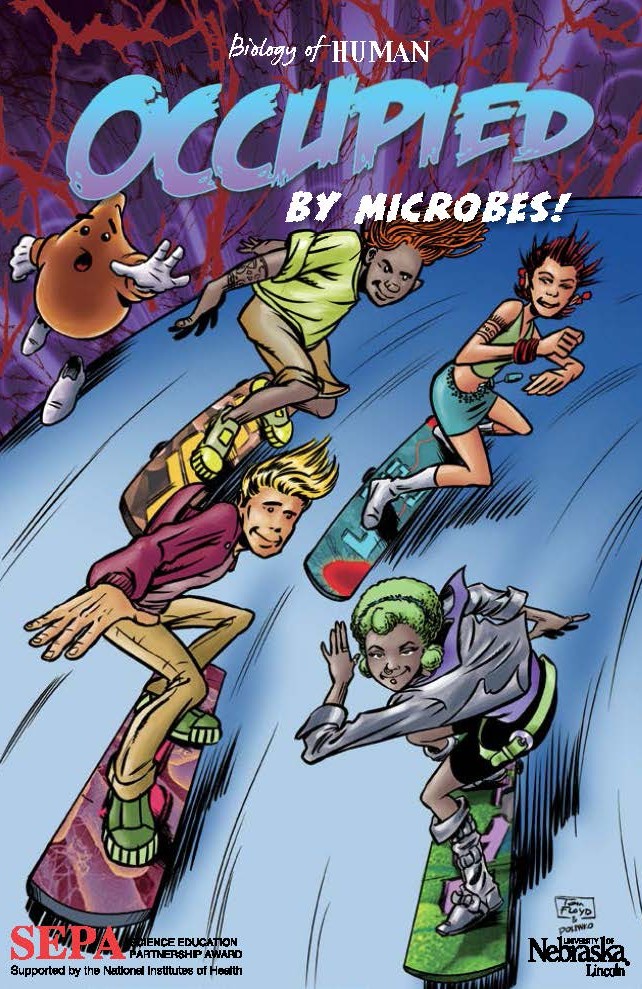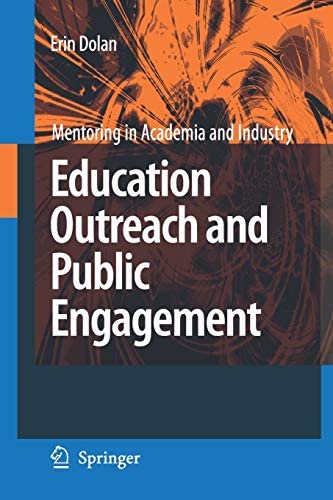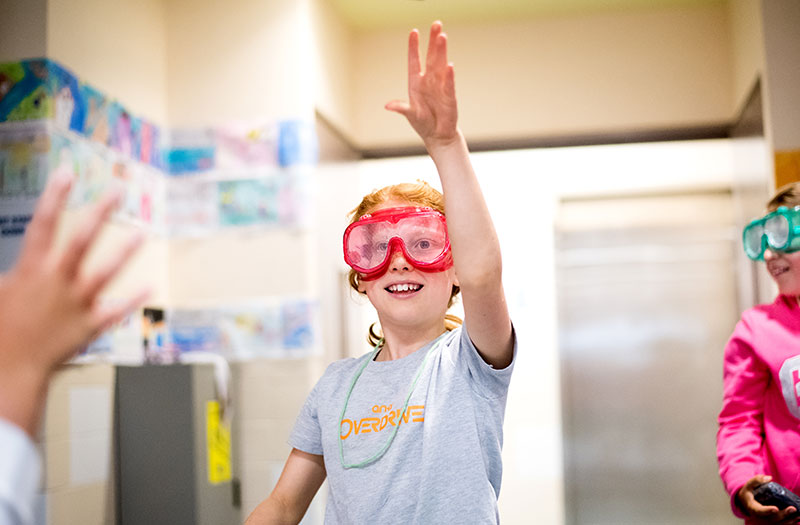Watch Your Mouth By Linda Allison, Rebecca Smith and Judy Diamond
Right now billions and billions of fungi, bacteria and viruses are coating your tongue, scumming up your teeth and flavoring your breath. There are more microbes in your mouth than there are people on earth. Horrible? Maybe. Healthy? For sure! Your mouth is home to an amazing mix of tiny critters. Because it’s a wet, warm cave, washed with a constant food supply it’s a perfect place for microbes to thrive. Worried? Don’t be. In fact, having a good mix of microbes keeps you healthy. So open wide and discover, experiment, observe.


STEM to Story: Enthralling and Effective Lesson Plans for Grades 5-8 by 826 National, Pañoringan, J. and Smith, R., Edited by Jennifer Traig. San Francisco: Jossey-Bass, 2015.
Available at Amazon.com or through Jossey-Bass publishing.
Occupied by Microbes by Martin Powell, Rebecca Smith, & Judy Diamond (writers). Illustrated by Tom Floyd (art) and by Nick Poliwko (inks and colors). University of Nebraska, Lincoln, 2014. App/PDF
Our bodies are home to more microbes than human cells. The balance of helpful to harmful microbes in our bodies can make us sick or healthy. The Biology of Human project focuses on helping people understand themselves by exploring scientific principles that underlie modern research in human biology.


Girls in Science: A Framework for Action by Liesl Chatman, Katherine Nielsen, Erin Strauss, and Kimberly Tanner with J Myron Atkin, Marjorie Bequette, and Michelle Phillips.
From 1994 – 2003, SEP led the Triad program with funding from the National Science Foundation. Triad brought scientists and teachers together to lead after-school science clubs with a focus on gender equitable science teaching. Participation in Triad required a commitment to extensive professional development on the part of both the teachers and scientists. The Triad community was highly collaborative, and participants together developed a framework for gender equitable science teaching and learning. This framework and reflections written by Triad teacher and scientist participants ultimately led to the publication in 2008 of Girls in Science: A Framework for Action by NSTA Press. Available through the NSTA Science Store.
Science Education Partnerships: Manual for Scientists and K-12 Teachers, edited by Art Sussman,University of California, San Francisco, 1993.
Copies of Sussman’s book are available for free from SEP. Drop by and pick one up or email us your request and mailing address to sep.info@ucsf.edu.


“Example of Complementary Professional Development for Teachers and Scientists: Current Science Seminar Series” by Katherine Nielsen, Rebecca Smith, Andrew Grillo-Hill, Patricia Caldera, Chantell Johnson, and Laura Gibson. In Erin Dolan (Ed.), Education Outreach and Public Engagement (pp. 58-61). New York, NY: Springer, 2008.
See it on Google Books.
“Critical Moments” by Elizabeth Liesl Chatman, and “Girls in Science: Full Partners” by Patricia Kudritzki, book chapters in Dilemmas in Professional Development: A Case-based Approach to Improving Practice, Tania Madfes and Judith H. Shulman, editors; San Francisco: WestEd / US DOE Western Regional Laboratory, 2000.
Book available on Amazon.com or at WestEd – Chatman’s chapter can be found on p. 58-64 in the pdf and Kudritzki’s on p. 35-42.

“Developing and Gathering Validity Evidence for an Instrument to Measure How High School Students Identify as Researchers” Research in Science Education, August 2024 by Linda Morell, Shruti Bathia, Bon W. Koo, Mark Wilson,
Perman Gochyyev, and Rebecca Smith
“Building Interdisciplinary Skills and Mentorship Opportunities in a 2-Week Research Experience” The Biophysicist, July 2024 by Yee-Hung Mark Chan, Michelle Phillips, Katherine Nielsen, and Diana S. Chu.
“Seeking a Better Balance Between Efficiency and Interpretability: Comparing the Likert Response Format With the Guttman Response Format” Psychological Methods, January 2022 by Mark Wilson, Shruti Bathia, Linda Morell, Perman Gochyyev, Bon W. Koo, and Rebecca Smith.
“Celebrating STEM Virtually: The Bay Area Science Festival During the COVID-19 Pandemic” Journal of STEM Outreach, Vol. 4, Issue 3, August 2021 by Sabine Jeske, MS, Jennifer Chu Kaelin, MS, and Katherine Nielsen, MA, MS
“Examining the Effects of a Peer-Learning Research Communityon the Development of Students’ Researcher Identity, Confidence, and STEM Interest and Engagement” Journal of STEM Outreach, Vol. 4, Issue 1, July 2021 by Bon W. Koo, Shruti Bathia, Linda Morell, Perman Gochyyev, Michelle Phillips, Mark Wilson, and Rebecca Smith
“Looking Back to Think Ahead: Reflections on Science Festival Evaluation and Research” Visitor Studies, 23:2, 205-217, Karen Peterman , Monae Verbeke & Katherine Nielsen (2020), DOI: 10.1080/10645578.2020.1773709
“Fostering Pathways: 30 Years of Inspiring High School Students to Pursue Science Careers through Biomedical Research Experiences” Journal of STEM Outreach, Vol. 3, Issue 2, August 2020 by Lakisha Witzel, M.S.; Jean MacCormack, M.A.; Katherine Nielsen, M.A, M.S.; and Rebecca Smith, Ph.D
“New, Not Different: Data-Driven Perspectives on Science Festival Audiences” Science Communication, 2019 by Katherine Nielsen, M. J. Gathings, and Karen Peterman
“Viruses, Vaccines, and the Public,” Museums and Social Issues, Vol.11, No.1, 2016 by Judy Diamond, Julia McQuillan, Amy N. Spiegel, Patricia Wonch Hill, Rebecca Smith, John West, and Charles Wood.
“Defining Success in Graduate School,” Molecular Biology of the Cell, Vol.25, No.13 2014 by Sean M. Bell, Jessica Blumstein, Katja Brose, Adam Carroll, Jean Chang, Julia Charles, Elizabeth S. Haswell, Melissa Michelitsc, Julia C. Owens, Christopher K. Patil, Rebecca Smith, Jon Tupy, Emily Walsh, and Tracy Ware.
“A Volunteer Army for Science,” Science. Vol.329, 2010 by Donald G. Rea and Katherine Nielsen.
“Injecting Inquiry into Photosynthesis Investigations,” Science Scope, 2008 by Irene Salter, Rebecca Smith, and Katherine Nielsen.
“A Natural Selection: Partnering Teachers and Scientists in the Classroom Laboratory Creates a Dynamic Learning Community,” The Science Teacher, 2005 by Marcelle Siegel, Susanna Mlynarczyk-Evans, Tamara Brenner, and Katherine Nielsen.
“Approaches to Biology Teaching and Learning: Science Teaching and Learning Across the School–University Divide—Cultivating Conversations through Scientist–Teacher Partnerships,” Cell Biology Education, Vol.2, No.4, 2003 by Kimberly Tanner, Elizabeth (Liesl) Chatman, and Deborah Allen.
“Approaches to Cell Biology Teaching: Cooperative Learning and Science Teaching – Beyond Students Working in Groups,” Cell Biology Education, Vol.2, No.1, 2003 by Kimberly Tanner, Elizabeth (Liesl) Chatman, and Deborah Allen.
“A successful university-school-district partnership to help San Francisco’s K-12 students learn about science and medicine,” Academic Medicine, Vol.71, No.9, 1996 by Margaret Clark.
“Cell and Molecular Biology for Minors: Review of Enjoy Your Cells by Fran Balkwill and Mic Rolph,” Cell Biology Education, Vol. 2, No. 1, 2003. Review written by: Rebecca Smith and Ruby Lipscomb.
Inspiring Scientists of All Ages by Smith, R.L. Editorial. Careers in Science Supplement to the San Francisco Chronicle. September 2013.
All of SEP’s programs are offered free-of-charge. To do this work, SEP must annually raise nearly $2 million. Every donation brings us closer to that goal and helps to make this important work possible.

As part of UCSF, SEP is a 501(c)3 non-profit. All donations are tax deductible to the fullest extent of the law. Please let us know if your company participates in a matching gift program so that we can extend the benefit of your generosity.